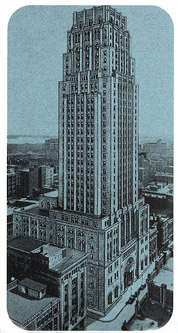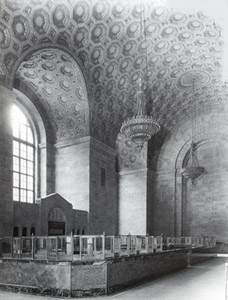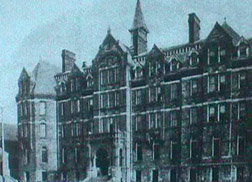William
McMaster: 1811-1887
Eminent
Canadian Benefactor
Integrity, Prudence,
Industry, Commerce.” These words are prominently inscribed in the magnificent
vaulted ceiling above the main floor in the historic head office of the
Canadian Bank of Commerce in downtown Toronto. A lifelong commitment to
the ideas and principles those visionary words imply made William McMaster,
the creator of that bank, a much respected businessman, community leader,
and humanitarian.
Through his success,
first as a wholesale merchant and later as a banker, McMaster became a
man whose considerable wealth enabled him to endow the internationally
acclaimed university in Hamilton, Ontario, named in his honour.
 |
This
anonymous portrait (circa 1880) of the Hon. William McMaster hangs in the
executive offices of the CIBC in downtown Toronto. McMaster, one of the
most successful businessmen in all of Canada, created the Canadian Bank
of Commerce in 1866, endowed McMaster University in 1887, and was a distinguished
member of the Parliament of Canada for 25 years. [Photo, courtesy CIBC
Archives]
|
Born in County Tyrone,
Northern Ireland, McMaster gained early experience as a clerk in an Irish
mercantile enterprise before coming to America as an immigrant, arriving
in York, now Toronto, in Upper Canada, August 1833.
Employed in the wholesale
and retail drygoods business in York owned by Robert Cathcart, McMaster
was soon made a partner. When Cathcart retired in 1844, McMaster became
the proprietor of the firm and soon devoted himself solely to the wholesale
trade.
Toronto’s rapid growth
from just over 9000 people in 1834 to about 30,000 in 1851 stimulated the
expansion of successful firms such as McMaster’s. By 1860, his company
was widely regarded as the major drygoods enterprise in Canada West, as
Upper Canada was known after 1840. His net worth was at least $600,000
by 1860.
McMaster’s success
as a businessman has been attributed to the careful but highly insightful
and utterly trustworthy manner in which he managed his business affairs.
There was also a direct connection between McMaster’s disciplined life,
emanating from his deeply held Christian convictions, and his success as
a businessman.
  |
1.
When the headquarters of the Canadian Bank of Commerce, viewed here, officially
opened in 1930, it was, at 476 feet or 144 metres, the tallest building
in the British Commonwealth. [Photo, courtesy Charles J. Humber Collection]
2. Stunning architectural interior of the banking hall on the main floor
of the old Canadian Bank of Commerce building on King Street West in downtown
Toronto, circa 1931. [Photo, courtesy CIBC Archives]
|
Until he was 40,
McMaster was completely absorbed in the development of his business and
committed to the Baptist church. In 1851, he married Mary Henderson of
New York City. Two nephews joined him in his wholesale enterprise: Arthur
Robinson McMaster, who was responsible for the financial records of the
firm, and James Short McMaster who managed the firm’s growing interests
in Great Britain. Gradually the McMasters developed a network of commercial
and financial associates in Toronto, Manchester, London, and New York.
As his nephews assumed
increased responsibility, McMaster devoted himself to wider business and
political interests. He became a director of several transportation companies
and pursued the development of the Great Western Railway, which merged
in 1882 with the Grand Trunk Railway and became the world’s most extensive
railway system. McMaster was also drawn into politics.
In 1862 he was elected
as a Liberal member of the Legislative Council of the United Provinces
of Canada. This elective body was responsible for the careful examination
of all legislation passed by the Legislative Assembly. It was the forerunner
of the non-elected Senate established by the British North America Act
of 1867.
In 1867, McMaster
was appointed a member of the Senate of Canada and remained a Senator until
his death 20 years later. As a Senator, he naturally, given his role as
the creator of the Canadian Bank of Commerce, took an interest in financial
matters.
As a wholesale merchant,
McMaster resisted the temptation to expand his business operations beyond
his financial capabilities. He also understood the role that banks and
the credit they might make available could play in developing and expanding
of business activities.
He became a director
of the Bank of Montreal in 1864 but was concerned by that bank’s ongoing
restriction of credit to businessmen in Canada West. Convinced that the
future development of business in Canada, west of the Ottawa River, should
not be limited by policies imposed by financiers in Montreal, McMaster
left the board of the Bank of Montreal and created his own bank to meet
those needs.
The establishment
of the Canadian Bank of Commerce was made possible after McMaster purchased
the charter of the Bank of Canada, which had been inactive since 1858,
and secured from the Canadian Parliament in 1866 an amendment to its charter
that changed its name to the Canadian Bank of Commerce and revised its
capital structure.
 |
McMaster
University is one of only three universities in Canada named after a Canadian.
Created in 1887 and endowed by the Hon. William McMaster, its first building,
viewed here, circa 1890, was located in Toronto on Bloor Street West, between
what is today the Royal Ontario Museum and Varsity Stadium. The building
still stands and is the home of the Royal Conservatory of Music. [Photo,
courtesy Charles J. Humber Collection]
|
In 1867, the Bank
of Montreal, at the time Canada’s largest bank, clearly favoured the United
States’ system of independent local banks prohibited from maintaining branches.
At the same time, an extensive branch banking system was developing in
Ontario. With the support of almost all Canadian bankers, except the Bank
of Montreal, McMaster worked vigorously to secure legislation to facilitate
the development of a branch banking system that, in his judgment, would
best meet the needs of Canadians.
After considerable
struggle, legislation passed in 1870 and 1871 put all banks in Canada on
the same footing and gave Ontario banks the authorization they required
to meet the banking needs of the province’s citizens.
With secure foundations
in place for his bank, McMaster took steps for careful expansion of its
operations. Drawing on the business relationships he had established for
his wholesale enterprise, McMaster encouraged the growth of international
business for his new bank. It had an agent in New York City by 1872 and
one in Chicago by 1875. It was also involved in currency trading on a widening
scale. In the decade and a half prior to his retirement as its first president,
McMaster provided the primary leadership that placed his bank at the front
rank of Canadian banking, second only to the Bank of Montreal established
in 1817, 50 years before the creation of the Commerce.
When he retired as
president in July 1886, McMaster proposed that younger men be appointed
to its board. One of these was George Albertus Cox who, named president
of the Commerce in 1890, three years after McMaster’s death, became one
of Canada’s most successful financial entrepreneurs.
While it might have
been advantageous, from a business perspective, for McMaster to become
a member of one of the larger and more influential church denominations,
he continued as a steadfast Baptist to the end of his days.
Three years after
his first wife, Mary, died in 1868, McMaster married Susan Moulton Fraser,
the widow of James Fraser, Indian paymaster for the Government of the United
States in Saginaw, Michigan.
Throughout his career,
McMaster supported Baptist initiatives in higher education. Among these
was the Canadian Literary Institute, created by an Act of the Canadian
Parliament in 1858, which opened in Woodstock, Ontario, in 1860. When its
building was destroyed by fire early in January 1861, McMaster immediately
made a substantial gift to ensure that it would be rebuilt, sustaining
its Baptist tradition. Its name was changed in 1883 to Woodstock College.
When the Toronto
Baptist College received its charter in 1881, McMaster paid for its lot
on Bloor Street West in Toronto and made a major contribution for the construction
of its building. It was incorporated as McMaster University in 1887. The
university moved to Hamilton in 1930, but the original McMaster building
still stands as the Royal Conservatory of Music in Toronto just west of
the Royal Ontario Museum.
Given McMaster’s
commitment to Christian principles and education, it is not surprising
to learn his last will and testament made specific provision for “an endowment
for a Christian School of Learning.” His will charged the Board of Governors
and the Senate of the new University to maintain it “with true and faithful
regard to the work of affording the best possible facilities for a thoroughly
practical Christian course of education...”
Before McMaster died
on September 22, 1887, he could look back on a remarkable 50-year business
career in Canada. A major commercial contribution was his creation of a
new Canadian bank that through his gifted leadership, has expanded to become
one of Canada’s leading financial institutions.
His crowning achievement
is the university that he endowed. In years that he did not see, McMaster
University has become a distinctive Canadian centre of learning through
which some 90,000 individuals from many countries have been able to develop,
refine, share, and use their higher sensibilities toward the improvement
of human and social life in an increasingly interconnected and complex
world.
William McMaster’s
dedication to Integrity, Prudence, Industry, Commerce is a dynamic model
for all who wish to improve the quality of life in the modern world.
D. McCormack Smyth



